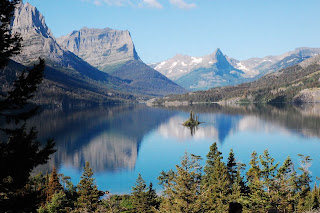





During five weeks in August and September of 2009 we ventured north, west, south and east. Our 5,400 mile trip included over 3,000 miles on state highways, which we found more challenging to drive but much more rewarding for the sights and experiences we enjoyed. From Branson we used Hwy 71 for most of the drive up to Grand Rapids, Minnesota for Jeanne’s high school reunion. While in Grand Rapids and Chisholm we visited with numerous family members and friends.
From Grand Rapids it was 1,200 miles due west on HWY 2, across Minnesota, North Dakota, and Montana to Glacier National Park. HWY 2 is a gem of a road, mostly four lanes, and picturesque in a way you would not see on an Interstate road. Along the way we repeatedly found ourselves in tiny campgrounds in small towns, with narrow sites that barely fit our coach (picture #1), with night time train sounds for musical entertainment, costing around $30 a night. Contrast that with the silent National Forest camp we used later near Flagstaff (picture #2) at $9 (the standard Federal rate!) a night.
As we drove west into the mountains we were reminded of the forest fires of recent years. Teepees became more frequent on the horizon. Picture #6 was our first real look at Glacier National Park, even grand on a cloudy day.









































